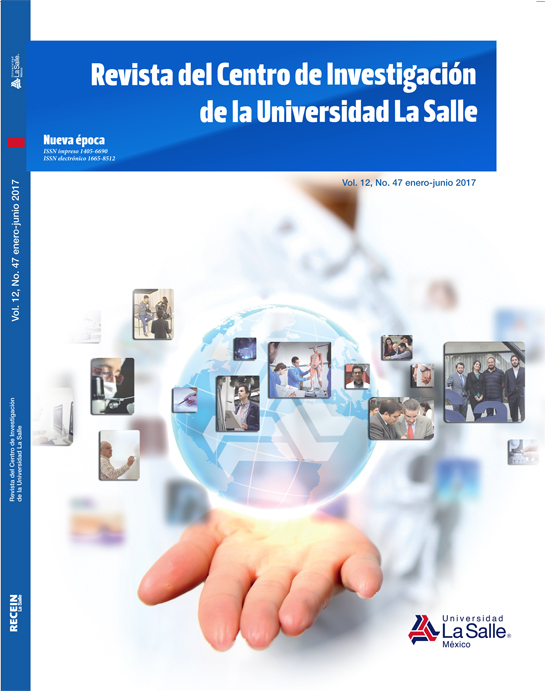Banda ancha digital e Innovación abierta: Primeras Impresiones en el Sector de Tecnologías de la Información1232
Barra lateral del artículo
Contenido principal del artículo
Resumen
Objetivo. El estudio está orientado a descubrir cómo la Banda Ancha Digital (DBD) está afectando la práctica de la Innovación Abierta (OIN) en el Sector de las tecnologías de Información de la Zona Metropolitana de Guadalajara, México (ITSZMG), para lograr un modelo que mejore sus relaciones.
Metodología. Es una investigación descriptiva, exploratoria, correlacional, transversal, cualitativa-cuantitativa. Como investigación cualitativa, se basó en una amplia revisión de la literatura tras la cual, se usó el Panel Delphi en conjunto con el Proceso de Análisis Jerárquico (AHP), determinando nuestros principales factores: DBD (1 factor/6variables/43 indicadores) y OIN (3 factores/ 23 variables/ 161 indicadores), en un cuestionario en escala de Likert, involucrando a 600 especialistas en 200 firmas Pyme de la ITSZMG. El levantamiento de datos fue en el periodo de Septiembre-Diciembre 2016.Como investigación cuantitativa, se aplicó Análisis Factorial Confirmatorio, usando el software EQS 6.2.
El valor del estudio, es el proponer un modelo generalizado involucrando las relaciones entre DBD-OIN para la ITSZMG, e identificar las variables subyacentes y sus relaciones para realizar recomendaciones sobre cómo ser más innovador, entre las firmas en el sector.
Los resultados finales: 5/6 variables del DBD, tuvieron un efecto positivo sobre 18/23 variables de la OIN. Esto significa oportunidades de desarrollo del modelo,
Conclusiones: Obtuvimos un modelo empírico capaz de identificar sus propias relaciones DBD-OIN para lograr ser, un firma de mayor innovación abierta en la ITSZMG.
Descargas
Detalles del artículo
El autor puede disponer de su artículo para su archivo en repositorios institucionales o en páginas web personales, con la referencia y agradecimientos a la fuente donde se ha publicado.
Citas
participate in open source biopharmaceutical innovation”. R&D Management. Jan, 40 (1), 50-66.
Anderson , J.C. Gerbing, D.,W. (1988), “Structural equation modeling in practice: a review
and recommended two-step approach”. Psychological Bulletin. 1 (3) 411-423.
Asakawa, K. Nakamura, H. Sawada, N.(2010), “ Firms' open innovation policies, laboratories'
external collaborations, and laboratories' R&D performance”. R&D Management. Mar, 40 (2), 109-123.
Autio, E. Thomas, LL.D.W. (2014), “Innovation Ecosystems: Implications for Innovation
Management. The Oxford Handbook of Innovation Management”. Oxford
University Press, Oxford.
Bagozzi, R.P. YI, Y.(1988) “On the evaluation of structural equation models”, Journal of the
Academy of Marketing Science, Vol.16 No.1. pp: 74-94
Bathelt, H. Malmberg, A. Maskel, P. (2004). “Clusters and Knowledge. Local Buzz, Global
Pipelines and the Process of Knowledge Creation”. Progress in Human Geography, 28, 31-36.
Byrne, B. M. (2006), Structural Equation Modeling With EQS, basic concepts,applications,
and programming, LEA Publishers, London.
Beckman, C. Haunschild, P. Philips, D. (2004). “Friends or Strangers? Firm-Specific
Uncertainity, Market Uncertainity and Network Partner Selection”. Organisation Science, Vol.15 No. 1, 259-275.
Bianchi, M.; Campodall'Orto, S.; Frattini, F.; Vercesi, P. 2010. “Enabling open innovation
in small- and medium-sized enterprises: how to find alternative applications for your technol gies”. R&D Management. Sep., 40 (4)
Biggs Ph.& Kelly,T. (2006). “Broadband pricing strategies”, info. 8 (6), 3-14.
Cohen, W. M. Nagata, A. Nelson, R.R. Wlash, J.P. (2002). “R&D Spillovers, Patents and the
Incentives to Innovate in Japanand the USA”. Research Policiy, 31, 1349-
1367
Cohen, W. and Levinthal D. (1990). “bsoprtive Capacity : A New Perspective on Learning and
Innovation”. Administrative Science Quarterly, 35, 128-152
Chesbrough, H. (2003). Open Innovation: The New Imperative for Creating and Profiting
from Technology. Harvard Business School Press. Boston, MA.
Chesbrough , H.and Teece, D.J. (2002). “Organizing for innovation: When is Virtual Virtous?”.
Harvard Business review,5-12.
Chesbrough, H. and Kardon –Crowter, A. (2006). Beyond high tech: early adopters of open
innovation in other industries. R&D Management. 36(3), 229-236.
Chesbrough, H.W. (2006). Open Business Models: How to Thrive in the New Innovation
Landscape. Boston, MA: Harvard Business School Press.
Chesbrough Henry W. (2007).Why Companies Should Have Open Business Models. MIT
Sloan Management Review. Winter 2007. 48 (2), 22-28.
Chesbrough, H. Bogers, M. (2014), “Explicating open innovation: Clarifying an emerging
paradigm for understanding innovation” in H. Chesbrough, W. Vanhaverbeke, & J. West (Eds.), New Frontiers in Open Innovation: pp.3-28. Oxford University Press.Oxford
Chien-Tzu, T. Wan-Fen, L. (2014). “A Framework for Open Innovation Assessment”.
International Journal of Innovation Management. Oct., 18 (5), 100-128
Chou, C.P., Bentler, P.M. and Satorra, A. (1991), “Scaled test statistics and robust standard errors
for nonnormal data in covariance structure analysis”, British Journal of Mathematical and Statistical Psychology, 44, 347-357.
Deloitte. (2015). Executing an Open Innovation Model: Cooperation is a Key to
Competition for Biopharmaceutical Companies. Deloitte Development LLC.USA.
Economista (2014.Feb.18). Jalisco quiere dar valor agregado a su clúster tecnológico. Retrieved
10-May-2016, from http://eleconomista.com.mx/estados/2014/02/18/jalisco-quiere-dar-valor-agregado-su-cluster-tecnologico
Enkel, E., Gassmann, O. Chesbrough, H. W. (2009). “Open R&D and open innovation:
Exploring the phenomenon”. R&D Management. 39 (4), 311-316.
EIRMA.(2003). Innovation through Spinning In and Out. WG60 Report. Paris
Estrategia Digital. (2013) Gobierno de la República. México, retrieved 11-May-2016 from:
http://cdn.mexicodigital.gob.mx/EstrategiaDigital.pdf
Etzkowitz, H. Leydesdorff, L. (1995). “The Triple Helix: University-Industry-Government
Relations: A Laboratory for Knowledge-Based Economic Development”, EASST Review. 14. 14-19.
Fichter, K. (2009), “Innovation communities: the role of networks of promotors in Open
Innovation”, R&D Management, 39 (4), 357-371
Fornell, CL. Larcker, D. (1981), “Evaluating structural equation models with
unobservable variables and measurement error”, Journal of Marketing Research,
18 (2),39-50.
Frost , Th. (2001). “The Geographic Sources of Foreign Subsidiaries of Innovation”.
Strategic Management Journal, 22,101-124.
Gassman, O. Enkel, E. (2004). Towards a Theory of Open Innovation: Three Core Process
Archetypes. 2-18. Retrieved 12-Jul-2016, from :
https://www.alexandria.unisg.ch/274/1/Gassmann_Enkel.pdf
Gassman , O. (2006). “Opening up the Innovation Process: Towards and Agenda”, R&D
Management. 36 (3), 223-228.
Gassmann, O. Enkel, E.Chesbrough, H. (2010). “The Future of Open Innovation”, R&D
Management, Jun, 40 (3), 213-221.
Goglio-Primard, K. Crespin –Mazet, F. (2014). “Organizing Open Innovation in Networks –
the role of boundary relations”, Management international, 9, 135-147.
Hair,J.F. Anderson, R.E. Tatham, R.L.; Black, W.C. (2014). Multivariate Data
Analysis. 7th Ed. Pearson, Prentice Hall, USA.
Hatcher, L. A. (1994).Step by Step Approach to Using the SAS System for Factor
Analysis and Structural Equation Modeling. Cary, NC: SAS Institute Inc. USA
Hopkins, M. Tidd, Joe; Nightingale, P. Miller, R.(2011), “Generative and degenerative
interactions: positive and negative dynamics of open, user-centric innovation in
technology and engineering consultancies”, R&D Management, Jan.,.41 (1), 44-60.
Horrigan, J.B.& Duggan , M. (2015). Home Broadband 2015. Dec.Pew Research Center.USA.
Hughes, B.& Wareham, J. (2010), “ Knowledge arbitrage in global pharma: a synthetic view
of absorptive capacity and open innovation”, R&D Management, Jun, 40 (3). 324-343
Hu, L.T., Bentler, P.M. and Kano, Y. (1992), “Can test statistics in covariance structure analysis
be trusted?”, Psychological Bulletin, 112, 351-362.
INSEAD and Booz, Allen & Hamilton. (2006). Innovation: Is Global the Way Forward?
INSEAD: Fointaneblau.
ITU-UNESCO. (2016). The State of Broadband 2014: Broadband for all. A report by the
Broadband Commission Sep 2016 . International Telecommunication Union (ITU) and the United Nations Educational, Scientific and Cultural Organization (UNESCO). Switzerland, Geneva.
Keup, M.M; Gassmann, O.(2009), “Determinants and archetype users of open innovation”,
R&D Management, Sep, 39 (4), 331-341.
Kim, D. 2010. “Application of the HoQ Framework to Improving QoE of Broadband Internet
Services”. IEEE Network. March-April, 20-26.
Kim,Y.; Kelly, T&Raja, S. 2010. Building broadband: Strategies and policies for the
developing world. Global Information and Communication Technologies (GICT) Department World Bank.USA
Kuemmerle, W. (1997), “Building Effective R&D Capabilities Abroad”, Harvard Business
Review. March-April, 61-70
Lichtenthaler, U.(2009), “Outbound open innovation and its effect on firm performance:
examining environmental influences”, R&D Management, Sep, 39 (4), 317-330
Lichtenthaler, U.; Holger E. (2009), “Opening up the innovation process: the role of
technology aggressiveness”, R&D Management, Jan, 39 , 38-54.
Lundvall, B.A. (1992). National Systems of Innovations, Pinter, London
Mejía-Trejo, J. Sanchez-Gutierrez, J. Ortiz-Barrera, A. (2013), “Leadership and Value
Creation on Innovation: The Case of Software Developer Sector in Guadalajara México”, Competition Forum. 11 (1), 24-31.
Miller, K.; Puthusserry, P.; McAdam, R.; Moffett, S.; Alexander, A. (2016), “Knowledge
transfer in university quadruple helix ecosystems: an absorptive capacity perspective”, R&D Management,Mar. 46 (2), 383-399.
Müller-Seitz, G.& Reger, G.(2009). “Is open source software living up to its promises?
Insights for open innovation management from two open source software-inspired projects”. R&D Management. Sep, 39 (4), 372-381
Nelson, R.R.(1993), National Innovation Systems: A Comparative Analysis, Oxford
University Press., Oxford.
OECD. (2003) Knowledge Management. Measuring Knowledge Management in the
Business Sector. First Steps, Organisation for Economic Co-operation and Development Publishing, Canada.
OECD. (2006). Digital Broadband Content .Digital content strategies and policies.
Organisation for Economic Co-operation and Development Publishing. France.
OECD. (2008a). Broadband and the Economy. Ministerial Bakground Report
Organisation for Economic Co-operation and Development Publishing.Korea
OECD. 2008b. Broadband Growth and Policies in OECD Countries. Organisation for
Economic Co-operation and Development Publishing. Korea
OECD. 2008c. Open Innovation in Global Networks. Organisation for Economic Co-
operation and Development Publishing.France.
Osterwalder, A. Pigneur, T (2010), Business Model Generation, John Wiley & Sons,
Inc., Hoboken, New Jersey
Rayna, T.and Striukova,L. (2014). “Open Innovation 2.0: Is co-creation the ultimate
challenge?”, International Journal of Technology Management, 69 (1), 100-118
Remneland-Wikhamn, B and Knights, D. (2012), “Transaction Cost Economics and
Open Innovation: Implications for Theory and Practice”, Creativity and Innovation Management, 21(3), 277-289.
Rohrbeck, R., Hölzle, K., Gemünden, H. G. (2009), “Opening up for competitive
advantage: How Deutsche Telekom creates an open innovation ecosystem”, R&D Management, 39 (4), 420-430.
Saaty, T. (1997). Decision Making for Leaders: The Analytical Hierarchy Process for
Decisions in a Complex World. Pittsburgh, PA: RWS.
Saebi, T. Foss, N.J. (2013), “Business models for open innovation: Matching Heterogenous
Open Innovation Strategies with Business Model Dimensions”, European Management Journal, 33 (3), 201-213.
Satorra, A. and Bentler, P.M. (1988), “Scaling corrections for chi square statistics in covariance
structure analysis”, American Statistics Association 1988 Proceedings of the Business and Economic Sections, 208-313.
Segars, A.H. and Grover, V. (1993),”Re-examining perceived ease of use and usefulness: a
confirmatory factor analysis”, MIS Quarterly, 17(4), 517-525.
Schwaag , S. (2006), “China , from Shop Floor to Knowledge Factory”, Swedish Institute for
Growth Policy Studies, 227-266.
Sieg, J.H. Wallin, M. W. Von Krogh, G. (2010), “Managerial challenges in open innovation:
a study of innovation intermediation in the chemical industry”, R&D Management. Jun, 40 (3), 281-291.
Sing, R.& Raja, S. (2008). Convergence in ICT services: Emerging regulatory responses to
multiple play.Worldbank.Washington.USA.
Thursby, J. Thursby, M. (2006), “Why the Firms Conduct R&D Where They Do”, Research
Technology Management, 49 (3), 5-16.
Tidd, J. (2006). A Review of Innovation Models. Discussion Paper 1. Tanaka Business
School, Imperial College, London.
Van der Borgh, M., Cloodt, M., and Romme, A. G. L. (2012), “Value creation by
knowledge-based ecosystems: Evidence from a field study”, R&D Management. 42 (2), 150-169.
Von Hippel, E. (2005). Democritizing Innovation: The evolving phenomenon of user
Innovation. Journal für Betriebswirtschaft. March. 55(19). 63–78. Springer.
West,J. & Bogers, M. (2014). “Leveraging External Sources of Innovation: A Review of
Research on Open Innovation”, Journal of Product Innovation Management 31 (4), 814–831.
Wunsch-Vincent, S. & Vickery G. (2007). Participative Web and User-Created Content: Web
2.0, Wikis and Social Networking. Organisation for Economic Co-operation and Development Publishing. Paris
 English
English


